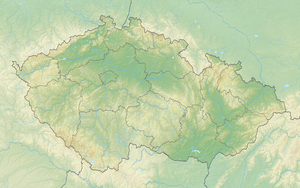Křemešník
| Křemešník | ||
|---|---|---|
|
Pípalka |
||
| height | 767 m nm | |
| location | Czech Republic | |
| Mountains | Bohemian-Moravian Highlands | |
| Coordinates | 49 ° 24 '14 " N , 15 ° 19' 39" E | |
|
|
||
The Křemešník (German Kremeschnik ) is a 767 m high mountain in the Czech Republic .
geography
The Křemešník is located nine kilometers southeast of Pelhřimov near the village of Sázava, Nový Rychnov , in the Bohemian-Moravian Highlands and is a place of pilgrimage to Mary. The Jankovský potok rises at its northeastern foot .
Structural systems
A Way of the Cross leads from the north-westerly direction from the Stříbrná studánka medicinal spring with an adjacent Baroque chapel from 1689 to the pilgrimage church of the Holy Trinity on the western peak.
The Křemešník is an old silver mining area. The citizen Matouš Chejstovský from Pelhřimov, who had fallen into a silver mine, had built a wooden chapel in 1555 as he had promised to thank him for being able to get out of the mine with his skin intact. In 1651 the town of Pelhřimov built a stone chapel in its place, which was consecrated in 1654 by the abbot of the Želiv monastery , Norbert von Amelung. The pilgrimage church was built between 1710 and 1720, and a cloister was added in 1734. After another expansion, it was consecrated in 1750 by the Prague Auxiliary Bishop Antonín Jan Vokoun. On the Way of the Cross lies the miraculous spring, which begins to bubble every year around the Apostle Matthias Day and then dries up into a trickle after a few months. Until 1803, the Franciscan Tertiary clergy and the Ivanite Hermit Congregation lived alternately on the mountain. From 1935 the Salesians of Don Bosco worked on the mountain.
The 52-meter-high Pípalka observation tower is located on the east summit. The steel structure was inaugurated in 1993 and has a viewing platform at a height of 40 meters, to which 205 steps lead up.
The Větrný zámek ( Wind Palace ) or U sedmi havranů ( The Seven Ravens ) in 1930 by the architect Kamil Hilbert as a villa for the sculptor Josef Šejnost built and resembles a Gothic castle. The remains of old silver tunnels can also be found on Křemešník .
Great pilgrimage
From 1763 the great pilgrimage to the Křemešník united Czechs and Germans from the neighboring Jihlava language island and from Bavaria. In 1834 there were 734 pilgrimages with 60,000 believers. The Křemešník became the main pilgrimage site of the Budweis diocese. In 1840 the Archbishop of Prague Alois Joseph Schrenck of Notzing made a pilgrimage from Kamenice nad Lipouan to the Křemešník. Confirmation took place in 1860 by Bishop Jan Valerián Jirsík , and later by Cardinal Friedrich Johannes Jacob Cölestin von Schwarzenberg . His successor Franziskus von Paula Schönborn made a pilgrimage from Vyskytná up the mountain on foot.
After the Second World War, the Prague Archbishop Josef Beran revived the great pilgrimage to the Křemešník. In 1948 the Budweiser Bishop Josef Hlouch led the pilgrimage for the last time. After the communists came to power, the great pilgrimage became a stumbling block. Archbishop Hloucha was first interned in 1949 and the abbot of the Želiv monastery, Bohumil Vít Tajovský, who was supposed to hold the pontifical mass on the Křemešník in Hloucha's place, was also arrested. After that there were no pilgrimages to Křemešník for almost 40 years.
After the fall of the communist regime, pilgrimages were resumed in 1989 and Cardinal Miloslav Vlk celebrated the first mass .

